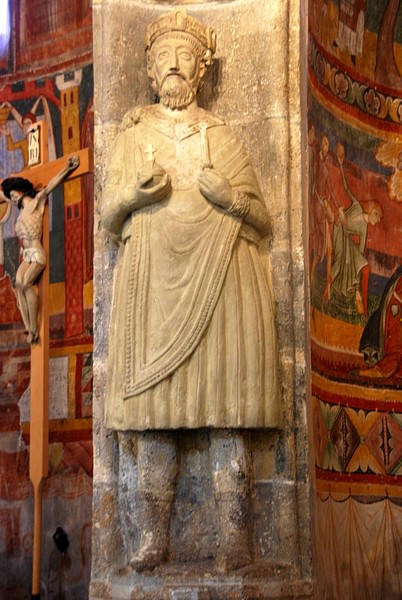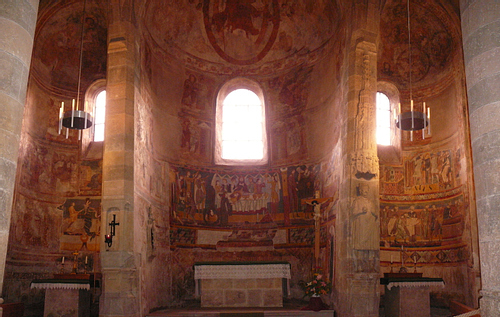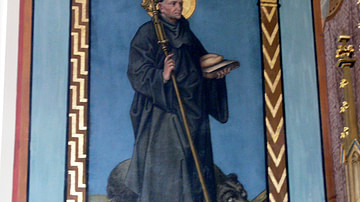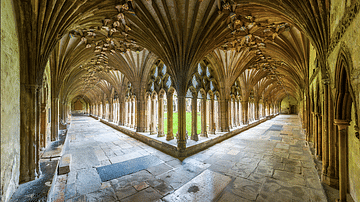
The Abbey of Saint John at Müstair, located in the village of Müstair in Canton Graubünden, Switzerland, is an early medieval Benedictine monastery dating to the late 8th century CE that became an abbey in 1163 CE. It is renowned across Europe and the world for its beautiful, intact medieval design and decor, and UNESCO designated it as a World Heritage Site in 1983 CE as a result of its splendid mix of Carolingian figurative murals, Romanesque frescoes, and ancient stuccoes. For over 1200 years, the Abbey of Saint John at Müstair has remained a Benedictine religious community.
Origins
The Abbey of Saint John in Müstair (German: Benediktinerinnenkloster St. Johann; French: Abbaye Saint-Jean-des-Sœurs; Italian: Monastero benedettino di San Giovanni; Romansh: Claustra benedictina da Son Jon) is set deep within the southern Swiss Alps in the Val Müstair, which is in Switzerland's Graubünden Canton. Müstair is the only Swiss territory to be in the Adige Basin, and it is Switzerland's easternmost village. The town of Müstair lies very close to the Swiss-Italian border in South Tyrol, and it is also close to the Swiss-Austrian border at Nauders, Austria. The Abbey of Saint John in Müstair is roughly 130 km (80 miles) from Chur, Switzerland and 65 km (40 miles) from Merano, Italy.
According to local traditions in Graubünden, Charlemagne (King of the Franks from 768-814 CE; King of the Lombards from 774-814 CE; and Holy Roman Emperor from 800-814 CE) founded the monastery at Müstair in the late 8th century CE. Legend states that as Charlemagne traversed the Umbrail Pass between the villages of Bormio and Santa Maria following his coronation as King of the Lombards in nearby Italy in 774 CE, he survived a snowstorm. There and then, Charlemagne decided to establish a monastery on the spot to commemorate his miraculous survival. Dendrochronology confirms that the wood used in the construction of the monastery was felled around c. 775 CE, so the legend could indeed be true. It is likely, however, that it was the Bishop of Chur who founded the monastery at Charlemagne's royal behest; Chur was the traditional capital of Graubünden and remains the canton's largest city too.
Aside from any miraculous survival and piety, Charlemagne undoubtedly recognized the region in and around Müstair as one of strategic and cultural importance. Lying between the trade- and pilgrimage routes, which crisscrossed the Alps between Switzerland, Germany, Austria, and Italy, Müstair was an ideal location for a Benedictine monastery that could operate as a hospice, accommodating pilgrims and travelers in the regions of Valtellina, Tyrol and Engadine. As a religious institution and center, the monastery would be able to tend to the religious needs of the local community as well.
History
A manuscript dated to c. 850 CE from the Abbey Cathedral of St. Gallen confirms that 45 monks lived in the monastery at Müstair around that time. Although many religious properties were sacked and looted when marauding armies of Muslim invaders pillaged alpine passes in what is present-day France, Switzerland, and Italy from c. 850-975 CE, the Abbey of Saint John in Müstair was spared harm or deprivation. Monks nonetheless fortified and reinforced existing structures throughout the 10th century CE.

By c. 900 CE, secular and ecclesiastical elites attest to the importance and power of the Benedictine religious community of Saint John at Müstair as the monastery served the Bishop of Chur as a secular residence and administration center. In 1163 CE, the monastery became an abbey, and although there were no monks at the abbey after that time, it retains nuns even now. Subsequent abbesses oversaw the construction of new buildings and renovations over the next 900 years, as the wealth and fame of the Abbey of Saint John increased across the Alps. New rooms, a chapel, a vaulted ceiling, and an impressive abbess' apartment complex reflect the power and prestige the abbey delineated to its visitors during the Middle Ages and Early Modern Era. Although the Swiss Reformation and the proclamation of the Ilanz Articles (1524 CE & 1526 CE diets that curbed the power of the Church) threatened the abbey's resources, the abbey and its artistic treasures survived the advance of Swiss Protestantism in Graubünden unscathed unlike other Catholic edifices in the Old Swiss Confederacy.
The Abbey of Saint John became famous as the site of the “Miracle of the Host of the Holy Blood” incident that took place between c. 1210-1230 CE. According to legend and tradition, a young nun named Agnes took the Eucharist but did not consume it after Mass one day. Rather, she hid it near her chest, where it soon transformed into flesh and blood. This relic brought even more pilgrims to the abbey from the 13th-15th centuries CE. Austrian troops looted the abbey and stole the relic following the Battle of Calven during the Swabian War of 1499 CE. The relic was, however, subsequently returned, but it was lost for good in 1799 CE when the French used the abbey as a military headquarters in their fight against the Austrian Empire. The French vandalized and desecrated most structures and rooms in the abbey during that time.
The last prince-bishop of Chur, Karl Rudolf von Buol-Schauenstein (r. 1794-1833 CE), saved the Abbey of Saint John in Müstair from dissolution in 1810 CE, but the Abbey became a priory instead under the leadership of a prioress.

The Art & Architecture of the abbey
The Benedictine Convent of Saint John at Müstair offers the visitor a mélange of different artistic and architectural styles, ranging from Carolingian and Romanesque to Gothic and Rococo. The convent consists of a conventual church which dates from the Carolingian era (c. 800 CE), the Saint Cross Church, the ancient residence of the Bishops of Chur, two geometric courtyards, and an early medieval residential tower that was redesigned and reconstructed by the Abbess Angelina von Planta in 1499 CE. (The Planta Tower is the oldest fortified-residential tower in the Alps, however, as it was first constructed by monks in c. 960 CE.) Abbess Angelina von Planta was also responsible for the transformation of the convent church, which had a single nave in Carolingian style, to that of a high triple-nave hall church between the years 1488-1492 CE.
It is in the conventual church that one can observe and admire the Carolingian frescoes that date back to the first half of the 9th century CE. Although the Carolingian frescoes and murals have lost their hue and some of their vibrancy due to the ravages of time, they remain the most important preserved Carolingian frescoes in situ in Europe. The Carolingian frescoes depict King David, various Christian saints, including Peter, Paul, Stephen, and John the Baptist, as well as scenes from the life and death of Jesus Christ. The Swiss architect Walther Sulser and Professor Linus Birchler discovered Romanesque wall paintings that date to c. 1200 CE between 1947-1951 CE. Those can now be seen in the abbey's museum.







